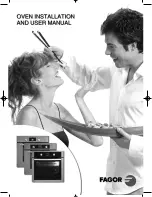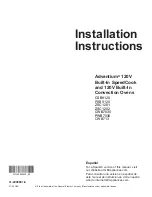
23
en
Oven cleaning and maintenance
Important
Before servicing the oven, always unplug it or disconnect the power at the main electrical system switch.
–
The stainless steel and enamelled parts will always remain like new if cleaned with water or specific products, drying
them thoroughly.
–
Never use scouring pads, steel wool, muriatic acid or other products that can scratch or mark the surface.
Do not use steam cleaners or direct jets of water.
–
Any stains (sauces, sugar, egg white and fat) on the bottom of the oven are always due to spills and splatters.
Spattering occurs during cooking at too high temperatures, whereas spills are due to the use of pots that are too
small or wrongly judged increases in volume during cooking. These two problems can be avoided by using pots with
high rims or using the drip-tray supplied with the oven. For cleaning the lower part of the oven, it is advisable to
clean any stains when the oven is still warm; stains are easily removed when fresh.
Removing the oven door
To facilitate oven cleaning, the oven door can be removed (see Fig. 3a, Fig. 3b and Fig. 3c), operating on the hinges
as follows:
–
The hinges (A) have two movable saddles (B). Lift the saddle (B) to release the hinge.
–
Then lift the door up and pull it outwards; to do this, hold the door at the sides near the hinges.
–
To refit the door, firstly insert the hinges in the special grooves.
–
Before closing the door, remember to turn the two movable saddles (B) previously used to release the two hinges.
Cleaning the oven door (Fig. 4)
–
The oven door must be cleaned (internally and externally) when the oven is completely cold, using hot water.
Do not use coarse cloths. Clean the glass with suitable detergents.
–
Do not use coarse abrasive materials or sharp metal scrapers to clean the glass parts of the oven door, as they
could scratch the surface and cause the glass to shatter.
–
Clean the enamelled surfaces and inside the oven with hot water and non-abrasive detergents.
–
The oven door’s plastic panel can be removed for more thorough cleaning. With the door open, press at the sides
and remove the panel, as shown in the figure. To refit the panel in the oven door, just slide it in place and press lightly
to engage the side hookings.
Removing the oven door internal glass (Fig. 2a/Fig. 2b/Fig. 2c)
The oven door can be removed to enable thorough cleaning of the internal glass, by proceeding as follows:
• with the door completely open, turn the two black blocks (with the word “CLEAN”) at the bottom of the door 180°
so that they insert in the seats in the oven structure.
NB
: Make sure to turn them fully (in this position the blocks
will click).
• Carefully lift the internal glass: the two blocks will prevent the door from closing (if the blocks are not turned fully,
removing the glass will cause immediate closing of the door).
After carrying out the cleaning operations, refit the internal glass (the correct position is indicated by the wording
“TEMPERED GLASS”, which must be perfectly readable) and turn the two glass retaining blocks back to their original
position.
ATTENTION:
Never try closing the door when only one or both blocks have partially or completely freed the internal
glass. After cleaning, always remember to turn both blocks before closing the door.
Removing the side frames (all models except SM 981 P)
Bend down the crosspiece engaged in the fixing bush and remove it from the groove.
Tilt the frame upwards approx. 60° and push it lightly in the direction of inclination. Keeping the frame tilted, remove the
two top hooks from the respective holes.
Fitting the side frames (all models except SM 981 P)
Keeping the frame tilted, insert the top hooks in the respective holes, pushing lightly in the direction of inclination.
With the frame tilted, pull in the direction of inclination until the top hooks stop against the outside of the compartment
wall.
Turn the frame towards the compartment wall. Bend down the crosspiece engaged in the fixing bush and remove it from
the groove.
Summary of Contents for CR 981 M M
Page 77: ...76 5 6 1 6 82 AA 40 5 Franke Franke 82 C C 10 D F D E F...
Page 79: ...78 2 Master Franke 150 C 3 200 C Franke 220 C 4 20 40 60 80 9 Franke Franke 60 60...
Page 80: ...79 gr SM 981 P SM 981 P 480 C A 330 C 180 P 1 2 3 LCD P LCD P Franke...
Page 82: ...81 gr C 1 15 C A C 8 00 30 13 00 C 13 00 13 0h30 13 00 C B...
Page 85: ...84 30 80 C 3a 3b 3c A B B B 4 2a 2b 2c 180 CLEAN TEMPERED GLASS SM 981 P 60...
Page 86: ...85 gr SM 981 P 5 Franke 300 C 220 240 V 50 60 Hz 25 W SM 981 P 15 W G9 SM 981 P E14 X Art S N...
Page 87: ...86 100 C 6 4 R 6a 6b FRANKE III 16 A...
Page 102: ...101 ru 5 6 1 6 107 AA 40 5 Franke Franke 107 C E D F D E F...
Page 105: ...104 Franke Franke 60 60 SM 981 P SM 981 P 480 C A 330 C 180 P 1 2 3 P P Protection Franke...
Page 107: ...106 B C 1 15 8 00 30 13 00 C 13 00 13 0h30 13 00 B...
Page 110: ...109 ru 3 30 80 C 3a 3b 3c A B B B 4 2a 2b 2c 180 CLEAN...
Page 112: ...111 ru 100 C 6...
Page 113: ...112 4 R 6a 6b FRANKE III a 16 A b c d e f 3 x 1 5 2 H05VV F g FRANKE...
Page 142: ...Franke S p A via Pignolini 2 37019 Peschiera del Garda VR www franke it 0385843 IM02...
















































